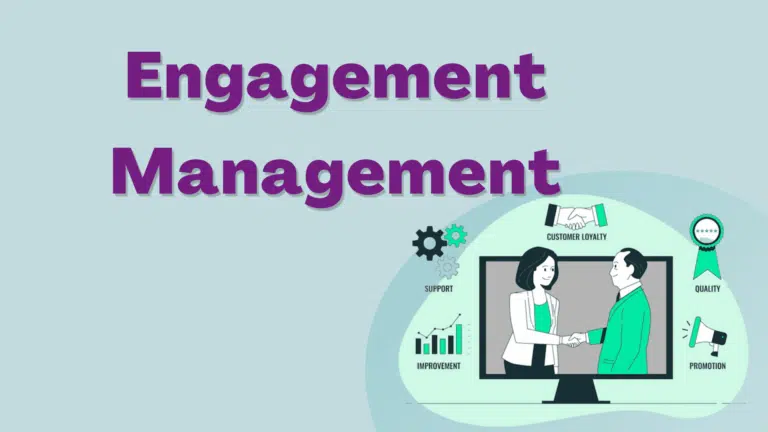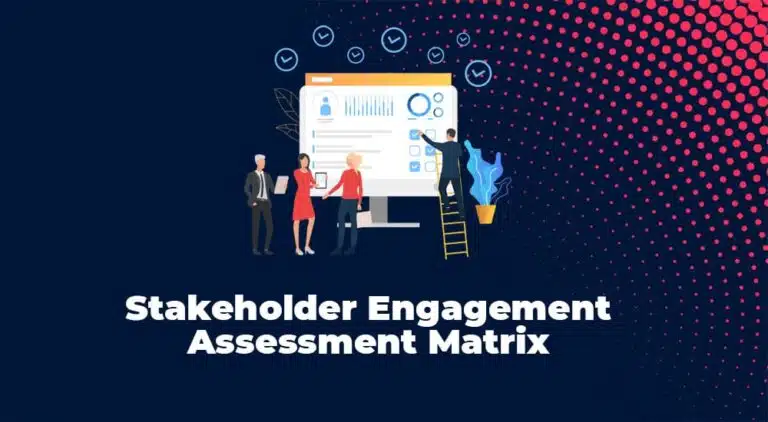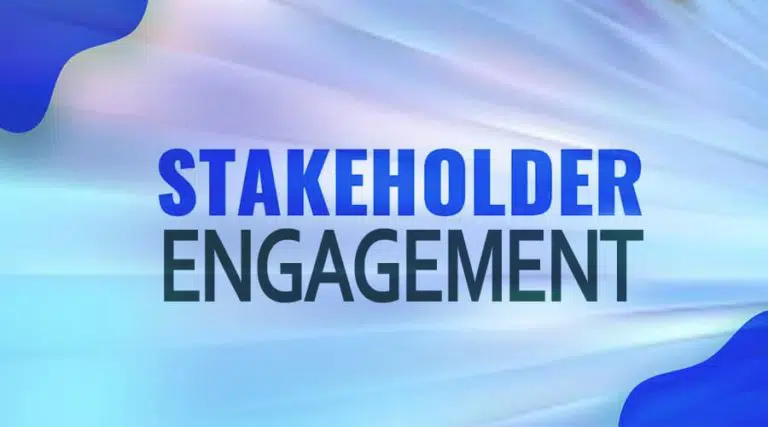All projects and business ventures are initiated to satisfy stakeholders. As a project manager, you will need stakeholder analysis to identify key stakeholders that you must satisfy to complete your project successfully.
A stakeholder map shows the power, interest, or influence of stakeholders on the project. This information lets you analyze stakeholders and plan your stakeholder engagement strategy.
In a nutshell, you must understand your stakeholders if you are managing a project or want to start a new venture.
In this blog post, I will explain:
- Who are stakeholders?
- What is stakeholder mapping?
- Why is stakeholder mapping important?
- How do you map stakeholders?
- What are some examples and templates of stakeholder mapping?
Who Are Stakeholders?
Project stakeholders are individuals or groups who are interested in the project or its outcome. They can influence or be influenced by the project’s objectives and outcomes.
You can classify stakeholders into different types based on their involvement, influence, and interest in the project.
Some common types of project stakeholders are:
- Project Sponsors: They provide financial and high-level support for your project, and they have a high influence and interest in the project.
- Project Team Members: They are highly interested in project success and have a moderate influence on the project resources and activities.
- Suppliers and Vendors: They are highly interested in project success but have moderate-to-little influence on project-related decisions.
- Regulators and Government Authorities: They are highly interested in ensuring regulatory compliance and can affect project constraints and requirements.
- Communities: They are highly interested in the project and can influence public opinion and occasionally project approvals.
Project team members, including the project manager, are also known as internal stakeholders. Rest are examples of external stakeholders.
What is Stakeholder Mapping?
A stakeholder map is a visual chart showing the individual or group interested in your project or business venture. This visual aid helps you classify the stakeholders so you can develop your strategy to manage them according to their requirements, interests, and influence.
Stakeholder mapping is key in analyzing stakeholders and developing a stakeholder engagement plan.
Importance of Stakeholder Mapping
A project can have dozens to thousands of stakeholders, and giving them equal importance is neither possible nor desired. You need to identify important stakeholders requiring close engagement and unimportant stakeholders requiring the least effort.
Stakeholder mapping maps the project stakeholders according to their power, influence, and interest in the project, and then you can classify the stakeholders and plan stakeholder management accordingly.
You can see which group of stakeholders is most influential and requires high attention and who are the low-level stakeholders requiring minimal effort.
Stakeholder mapping helps you analyze your stakeholders, as well as develop effective stakeholder communication and management plans.
When Should You Use Stakeholder Mapping?
You can use stakeholder mapping in the following cases:
1. When Developing a New Product
To develop a new product, you will need to know who will use your product and who can influence your product development process.
In this case, stakeholders can include users, team members, management, suppliers, contractors, shareholders, and government authorities.
2. When Entering a New Market
You must map your stakeholders to understand their needs and preferences when entering a new market.
In this case, stakeholders can include distributors, retailers, or customers.
3. When Starting a New Project
When starting a new project, you will need to map your stakeholders so you can analyze and satisfy them based on their needs and expectations.
A project can be inclusive of but not limited to the following stakeholders:
- Project Sponsors
- Management
- Team Members
- Suppliers
- Contractors
- End-Users
- Government Authorities
- Local Communities
4. When Launching a New Product
When launching a new product, you need to know your target audience to market your product well.
In this case, the stakeholders can include but are not limited to:
- End-Users
- Distributors
- Marketing Personnel
- Retailers
How to Map Relationships with Stakeholders
After completing the stakeholder identification process, you map the stakeholders using their relationship with the project or its objectives.
You have various methods to map the stakeholders. You can use a graphical method or create a Word file with a list of stakeholders and their power, interest, and influence on the project.
The list-based method is useful for projects with fewer stakeholders. If you have a large project, graphical methods are more useful.
You can use the following graphical tool to map stakeholder relationships within the project:
- Power/Influence/Interest Grid
- Salience Model
- Direction of Influence
- Stakeholder Cube
#1. Power/Influence/Interest Grid
This is the most popular method to categorize a large number of stakeholders.
Developing a strategy for large stakeholders may be difficult, so you group them according to their requirements/expectations, power, interest, or influence in this method. You can then plan your engagement strategy to manage these groups.
Power
This is the stakeholders’ authority over the project. You can also define it as an ability to influence the work.
The project management team must evaluate how this power can support the project.
Influence
This attribute is closely related to power. Here, stakeholders can affect project outcomes.
Interest
This is the stakeholders’ level of concern about a project or their desire to be involved. Understanding stakeholder needs and their level of interest is critical to creating a management plan.
Now you understand these attributes, let’s discuss the power/interest grid model.
Power and Interest Grid
This grid has power on the vertical axis (i.e., the x-axis) and interest on the horizontal axis (i.e., the y-axis). You can place stakeholders in four quadrants according to their power and interest.
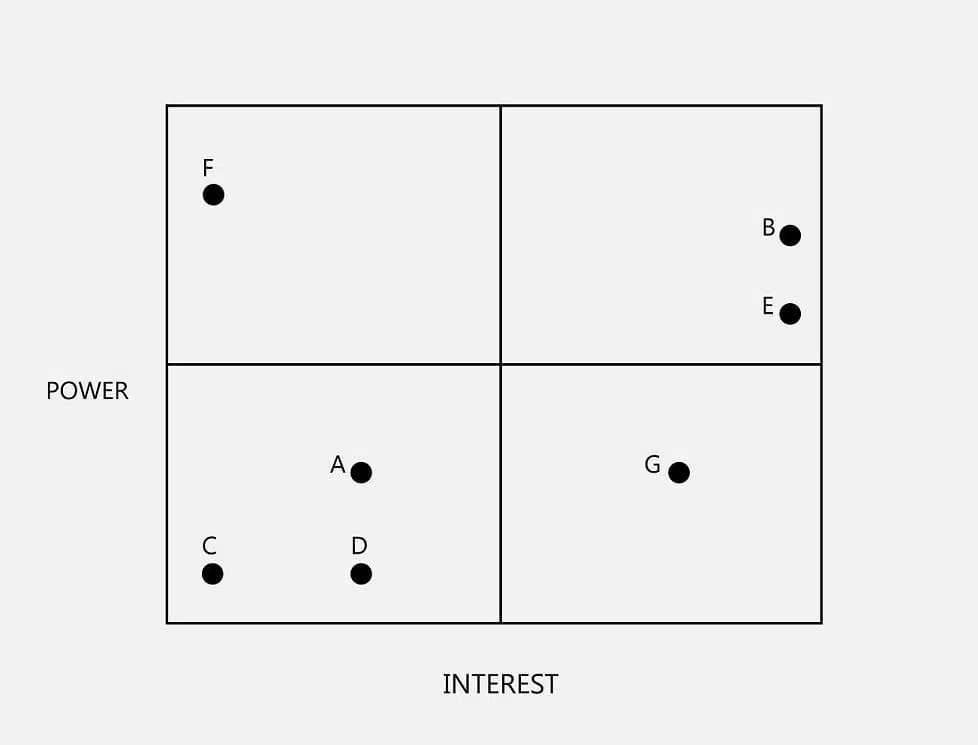
You can group stakeholders as follows:
- High Power, High Interest: These are stakeholders marked B and E in the diagram above.
- High Power, Low Interest: These are marked F in the diagram above.
- Low Power, High Interest: These are marked G in the diagram above.
- Low Power, Low Interest: These are stakeholders marked A, C, and D in the diagram above.
You cannot give the same attention to all stakeholders. The power and interest grid map them so you can classify and manage them according to their requirements.
The diagram below gives the recommended actions for all four possibilities.
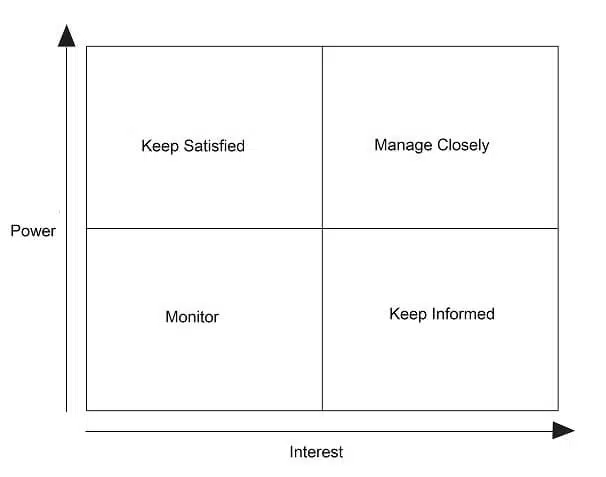

Power and Influence Grid
Here, you can group stakeholders according to their power and influence over the project. This model is not as popular as the power and interest grid due to the similarities between power and influence metrics.
Influence and Impact Grid
Here, you classify stakeholders based on their influence and impact on the project.
You can group the stakeholders as follows: high-influence or low-influence, high-impact or low-impact.
#2. Salience Model
This stakeholder mapping model uses three parameters to group stakeholders.
The parameters are power, urgency, and legitimacy, as follows:
- Power: This is the stakeholder’s ability to influence the organization or outcome of the project.
- Urgency: This is the stakeholder’s expectation for quick responses to their needs or requests.
- Legitimacy: This is the stakeholder’s right to be involved, as well as the stakeholder’s relationship with the firm.
Salience is defined as “the degree to which project managers prioritize stakeholders.” The more attributes (i.e., power, urgency, and legitimacy) a stakeholder is perceived to have, the higher their salience will be from a manager’s perspective.
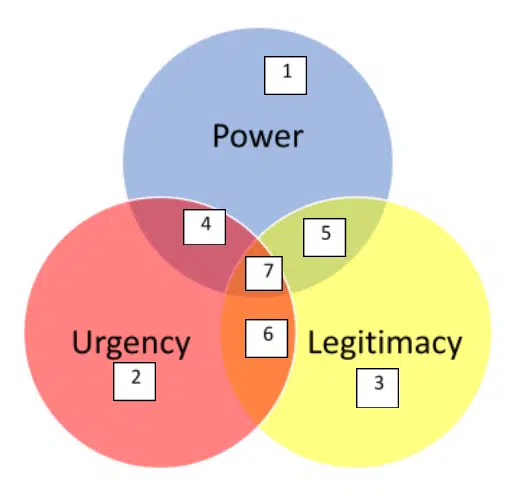
This gives us seven possibilities, namely:

Behavioral Implications
Latent stakeholders have the power of imposition, but they may not get the attention they expect due to a lack of legitimacy.
Demanding stakeholders may have urgent claims, but they may not have power or legitimacy. However, they can influence other stakeholders, and therefore, they should be managed carefully.
Examples include serial complainers and unjustified grudges.
Discretionary stakeholders have an established relationship with the managers but no power or urgency, like charity beneficiaries and NGOs. You will fulfill their needs because of legitimacy, but they are not normally given priority.
Dangerous stakeholders have both power and a sense of urgency. They can be volatile, and although they do not have legitimacy, they can still cause trouble for your project if they are not effectively managed (e.g., local vandals).
Dominant stakeholders have power and legitimacy but do not have a sense of urgency. An example would be local authorities during a construction project.
Dependent stakeholders possess legitimacy and urgency but lack the authority or power to enforce or coerce. Manage them carefully. They can gain power by grouping with powerful stakeholders. An example of this is the residents surrounding a community construction project.
Core or Definitive stakeholders exhibit all three attributes. They have the authority, rights, and needs, so they should be given the highest priority.
#3. Direction of Influence
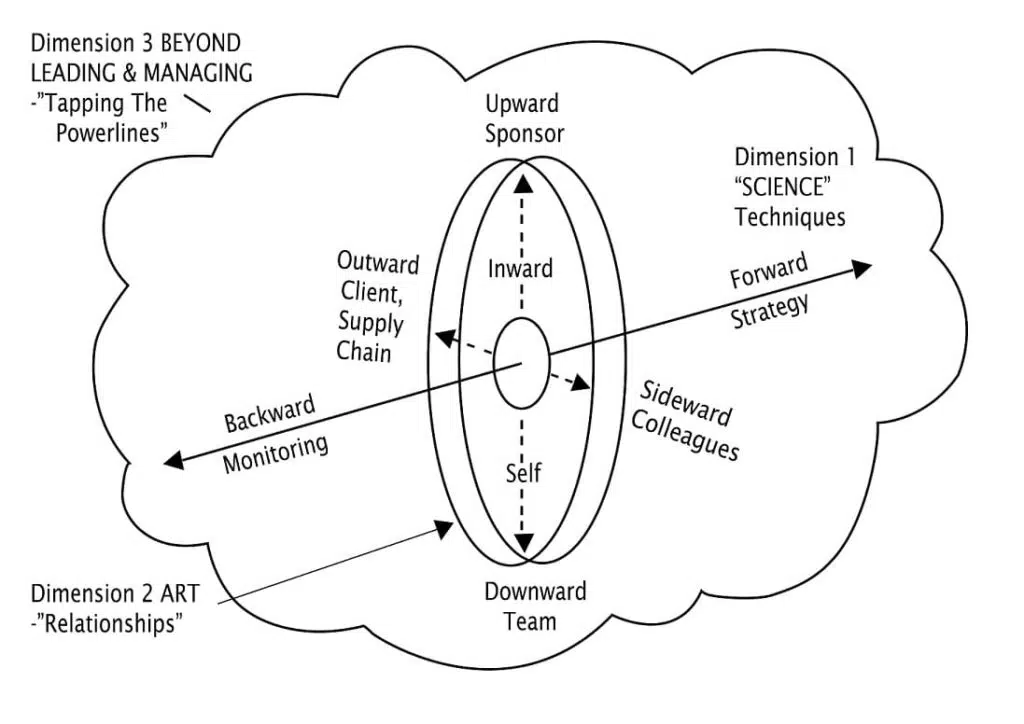
As shown in the figure above, you can group stakeholders according to their direction of influence in four different ways:
- Upward Stakeholders: These are high-level executives. The diagram above shows that the project sponsor is a typical example. Other examples are the organization’s management, STEERCO (i.e., project steering committees), and customer organizations.
- Downward Stakeholders: These are below the project manager in terms of authority (e.g., project team members).
- Sideways Stakeholders: These stakeholders are at the same level as the project manager. They require a good, informal relationship. They can also help garner project support.
- Outward Relationships: These are the organization’s external relationships (e.g., vendors, suppliers, external end-users, regulators, and civil defense groups).
#4. Stakeholder Cube
This model looks at a three-dimensional stakeholder representation other than the salient model.
The stakeholder cube considers:
- Attitude: This is the stakeholder’s disposition and whether they are for or against the project. Are they a backer or a blocker?
- Power: This is the stakeholder’s authority to influence the project outcome.
- Interest: This is the stakeholder’s expectation or involvement in the project. Here is where you will distinguish interest from attitude. A stakeholder may be interested in the project, but what is their motive? Positive interest creates a project backer, while negative interest can lead to a project blocker. Some stakeholders may only be interested in the project to block its success.
The stakeholder cube captures eight possibilities, as shown in the figure below.
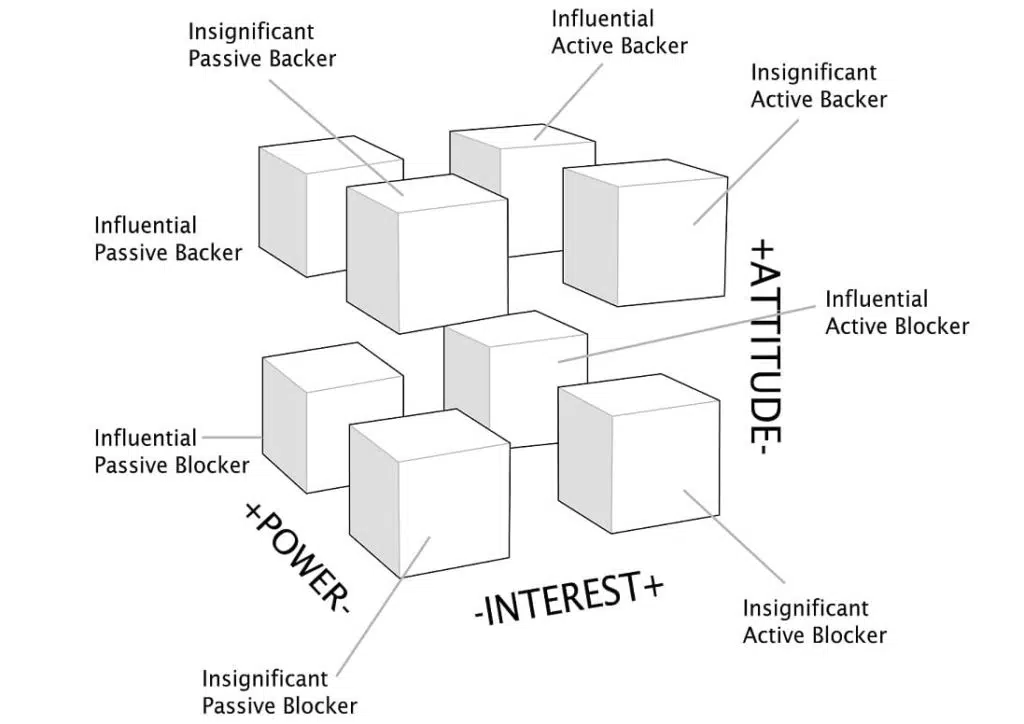
The diagram above is elucidated in the table below. Note that the plus sign (+) indicates high, while the minus sign (-) indicates low.

The influential passive blockers are time bombs. They have power—and you don’t want them to use it against your project! You need to understand these stakeholders to defuse the bomb before it goes off.
Influential active blockers are saboteurs. Your goal should be to disengage them from the project.
Insignificant passive blockers are like a tripwire.
Insignificant active backers are friends of the project.
Influential active backers are beyond friends; they are saviors and have the power to rescue or salvage a situation.
Insignificant passive backers are acquaintances; they are aware of the project and are not against it but have not shown much commitment. They are less than friends of the project.
Influential passive backers are like sleeping giants; they are assets only if they gain interest in the project. For some reason, they do not want to be seen as committed, perhaps because of their public status.
Insignificant active blockers are an irritant, as their interest is not in project success.
The stakeholder cube is an interesting tool to deploy when strategizing how to manage stakeholders.
The last aspect of stakeholder mapping is prioritization. This is a key aspect, as you sometimes have projects with many stakeholders. For example, your company is building a new business model impacting 600 administrative-level employees.
You cannot capture all 600 people in the stakeholder register. However, you can quickly use the power and impact grid to categorize and manage them. For low-impact/high-interest stakeholders, you must simply keep them informed.
Stakeholder Map Template
You can use the following template to map your stakeholders:
#1. Stakeholder Matrix Map

#2. Stakeholder Salience Model

#3. Direction of Influence

#4. Stakeholder Cube

Stakeholder Map Example
Let’s consider a Power and Interest Grid to show a stakeholder map.
Here is where you will plot power on the y-axis (i.e., vertical axis) and the level of interest on the x-axis (i.e., horizontal axis).
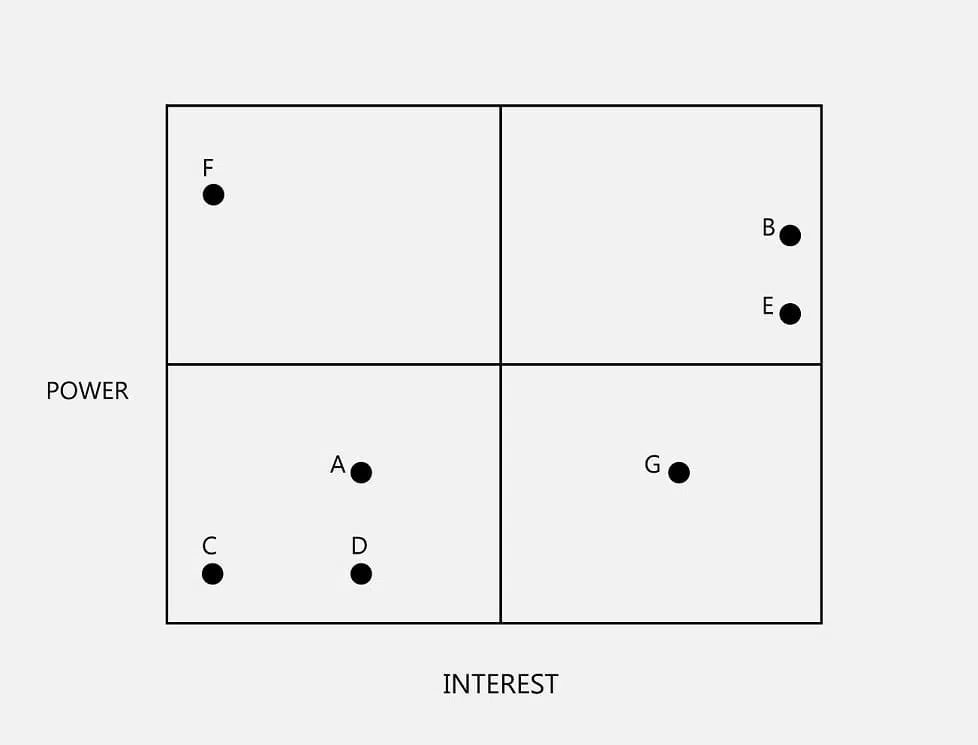
There are four possibilities:
- High Power, High Interest: These are stakeholders marked B and E in the diagram above.
- High Power, Low Interest: These are stakeholders marked F in the diagram above.
- Low Power, High Interest: These are stakeholders marked G in the diagram above.
- Low Power, Low Interest: These are stakeholders marked A, C, and D in the diagram above.
The position held by stakeholders determines the management strategy.
How to Create a Stakeholder Map
The stakeholder-mapping process can include the following steps:
- Identify Your Stakeholders: The first step is to identify your project stakeholders. If the project is small, you can count it yourself, but a bigger project takes time. You can include your team members in a brainstorming session to find stakeholders. In this session, you can also include concerned people from your organization, clients, government authorities, local communities, etc. After identifying your project stakeholders, you will record this information on a stakeholder register.
- Determine the Level of Involvement: After identifying stakeholders, you must find each stakeholder’s level of influence on your project. If the project is large and involves many stakeholders, then you can group them together and then find the whole group’s involvement. You will find their interest, influence, and power in the project, as well as the objective or outcome. After completing this process, you will update the risk register.
- Determine the Stakeholder-Mapping Framework: Now, you have all the available information required to draw your stakeholder map. Next, you will decide which framework to use. Some popular frameworks are grid-based maps, salience models, and stakeholder cubes. The selected framework will depend on your specific needs and preferences. Consider factors like simplicity, attention to detail, and flexibility. You can see what other project managers in your organization are already using, or you can experiment with a new framework.
- Map the Stakeholders on the Chart: Finally, you will select the stakeholder-mapping template and fill in the stakeholders in the designated place. Now, your stakeholder map is ready. (Note: The stakeholder map is a live project document. Therefore, you must monitor your stakeholders continuously and update the map whenever you identify a new stakeholder or the status of any stakeholder changes.
Summary
A stakeholder map is a visual representation of stakeholders. It is vital in project management, as it provides the key information needed to draft effective stakeholder communication and engagement plans, as well as to meet all stakeholders’ needs. Remember, you must create your stakeholder map before you develop your project management plans.

I am Mohammad Fahad Usmani, B.E. PMP, PMI-RMP. I have been blogging on project management topics since 2011. To date, thousands of professionals have passed the PMP exam using my resources.



